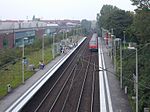Gelsenkirchen Hauptbahnhof
1847 establishments in PrussiaBuildings and structures in GelsenkirchenNorth Rhine-Westphalia railway station stubsRailway stations in Germany opened in 1847Railway stations in North Rhine-Westphalia ... and 3 more
Rhine-Ruhr S-Bahn stationsRhine-Ruhr S-Bahn stubsS2 (Rhine-Ruhr S-Bahn)

Gelsenkirchen Hauptbahnhof is a railway station in the German city of Gelsenkirchen. It connects the city to the regional and long-distance rail service of Deutsche Bahn and other railway companies in Germany.
Excerpt from the Wikipedia article Gelsenkirchen Hauptbahnhof (License: CC BY-SA 3.0, Authors, Images).Gelsenkirchen Hauptbahnhof
Hiberniastraße, Gelsenkirchen Altstadt (Gelsenkirchen-Mitte)
Geographical coordinates (GPS) Address Nearby Places Show on map
Geographical coordinates (GPS)
| Latitude | Longitude |
|---|---|
| N 51.504444444444 ° | E 7.1013888888889 ° |
Address
Gelsenkirchen Hbf
Hiberniastraße
45879 Gelsenkirchen, Altstadt (Gelsenkirchen-Mitte)
North Rhine-Westphalia, Germany
Open on Google Maps










